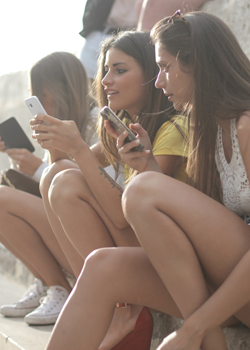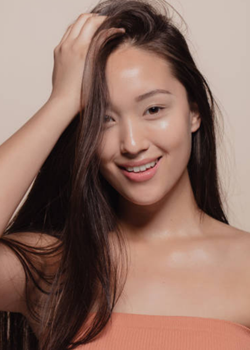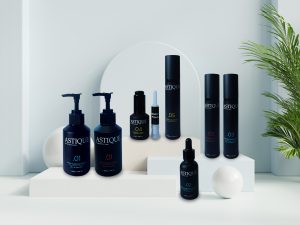- OUR STORY
- AESTHETIC CARE
-
-
-
FACE
EYE
-
INJECTABLES
LASER
-
BODY
MULTIMODAL TREATMENTS
-
-
-
- YOUR CONCERN
-
-
Pages
- “Living Your BrEaST Life” with Dr. Mok Chi Wei
- “More Than Just Skin Deep” with Dr. Melvin Ee
- “Most Common Skin Conditions” with Dr. Yong Zhi Yong
- “Ouch! My foot pain” with Dr Gowreeson
- “Trust Your Gut Feeling” with Dr Colin Koh
- “When You Can’t Hold” with Dr. Christopher Chong
- Acne Healing Cream
- Acne Scar Laser Treatment
- Acne Treatment Package
- Aesthetic Treatments for Women
- AsiaMedic’s 25th Anniversary
- Astique Crystal Tomato
- Astique Hydrating Gel
- Astique Miracle Wash
- Astique Skincare Range
- Beauty Aesthetics
- Blog
- Book an Appointment
- Brides Package
- Ceramide Moisturizer
- Chemical Peel
- Clarifying AHA Facial Cleanser
- CoolSculpting
- CoolSculpting Body Shape @ Tummy Treatment Package
- Coolsculpting Singapore
- December Update
- Dermal Fillers
- Dr. Eileen Lew
- Dr. Elendrus Teo
- Dr. Tiffiny Yang
- Dual Yellow Laser
- Eye Rejuvenation Treatment Package
- Facial Treatment Singapore
- Fillers Singapore
- Fotona 4D
- Fotona 4D Singapore
- Fotona Acne & Acne Scar Laser Treatment
- Fractional Laser
- Gentle Cleansing Emulsion
- Get Rid of that Unwanted Hair with IPL Hair Removal
- HA Injectible
- HIFU
- How Skin Tightening Treatments Can Help You
- HydraFacial
- Intensive C Serum
- Intensive Hydrating HAB5 Serum
- July 2022 Promotion
- LDM – Aloha EX
- LDM-MED
- Light Mattifying Gel
- Light Therapy
- May 2022 Promotion
- Medi Facial
- Microdermabrasion
- Our Story
- Our Story
- PDRN Skin Booster
- Pico Laser
- Pigment Control Serum
- Pink of Health
- Privacy Policy
- Products
- Profhilo
- Profhilo In Singapore
- Q-Switched (ND-YAG) Laser
- Radiance Laser Treatment Package
- Radiance Moisturizing Cream
- Radiant Skin
- Retinol Optimiser
- SharpLight IPL
- Sitemap
- Thank you
- Thermage
- Treating Dark Circles Under Eyes with Eye Aesthetics
- Ulthera
- Whistleblowing Policy
- Yellow Laser
- Yellow Pigmentation Removal
-
ENHANCING FACIAL FEATURE
DULL & UNEVEN SKIN TONE
-
SKIN PIGMENTATION / REJUVENATION
WRINKLES REDUCTION
-
ACNE & ACNE SCAR
DARK EYE CIRCLES
-
LOOSE SKIN
HAIR REMOVAL
SKIN LUMPS/MOLES
-
-
- SHOP
-
-
ASTIQUE IN-HOUSE SKINCARE
-
DRY AND SENSITIVE
ACNE & OILY SKIN
-
SERUM
-
-
- BLOG
- BOOK AN APPOINTMENT
Q-Switched (ND-YAG) Laser - The Extended Platform for freckles, post-acne scarring, melasma and even tattoo removal
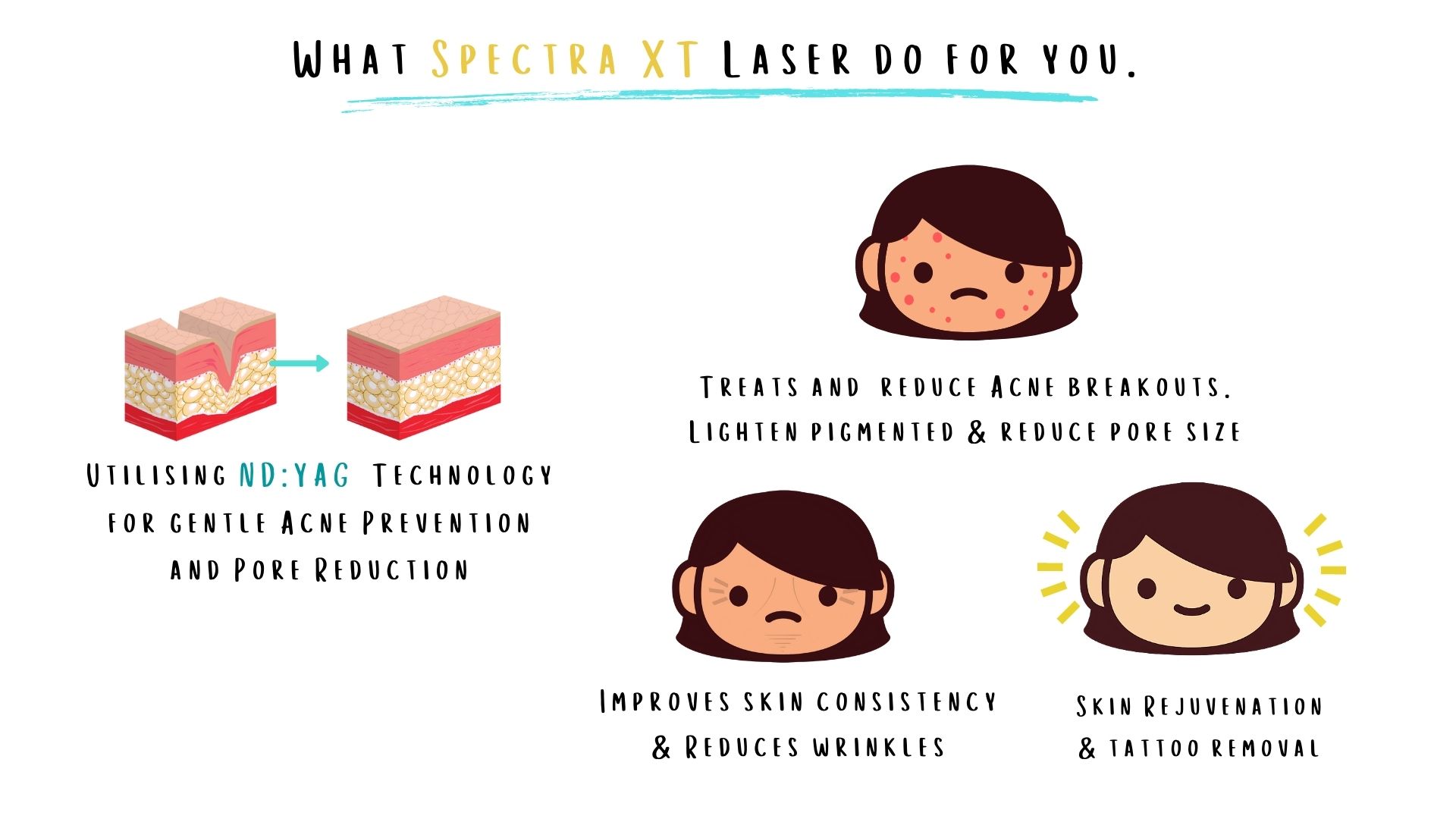
What is Q-Switched (ND-YAG) Laser?
Q-Switched (ND-YAG) Laser is a multi-platform Nd-YAG-based laser.
Q-Switched (ND-YAG) Laser offers four adjustable wavelengths that provide a wide variety of pigmentation treatments solution including
- Post-acne marks
- Melasma
- Freckles,
- Lentigines ( sun spots/ age spots) and
- Pigmented birthmark.
Being the first approved tattoo removal and melasma laser machine, Q-Switched (ND-YAG) Laser offers four adjustable wavelengths and various safe treatment options for most skin types and with minimal downtime.
How Does Q-Switched (ND-YAG) Laser work?
Q-Switched (ND-YAG) Laser offers four adjustable wavelengths to treat various skin conditions. It ranges from 532 nm to 1064 nm. They are categorized based on short to long wavelengths. Different wavelengths or colours of laser light will have different effects on the skin.
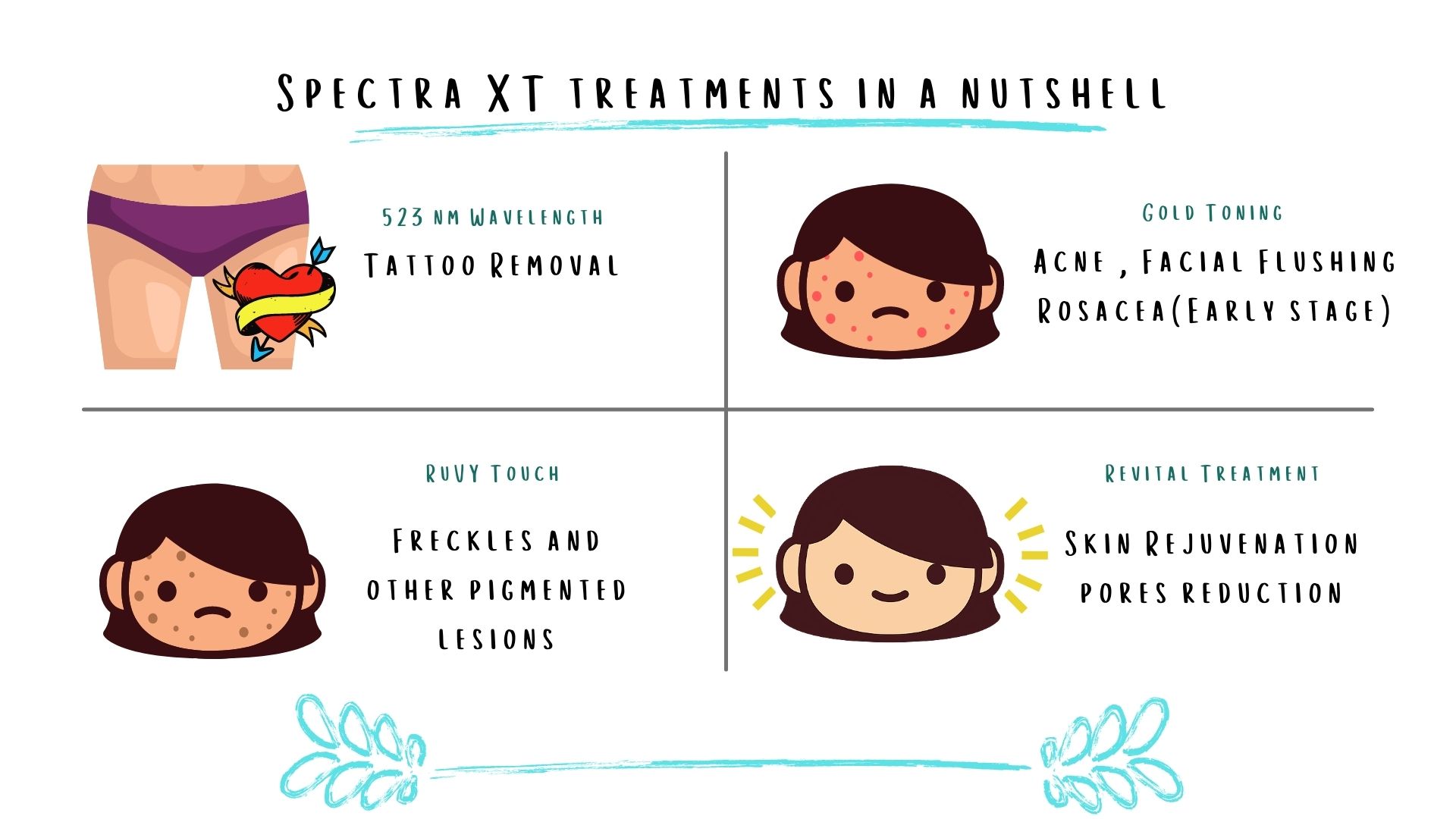
The four wavelengths of Q-Switched (ND-YAG) Laser available
1. Q-Switched (ND-YAG) Laser 532 nm
532 nm wavelength is used mainly for removal of red, orange, yellow and brown tattoos as it is absorbed by these colours and and the energy from the laser breaks the ink particles in the tattoo into tiny fragments and is absorbed by the body. It can also be used to treat superficial epidermal pigments, however with the advent of the Ruvy laser, which is much safer, this feature is now used less and less.
2. Q-Switched (ND-YAG) Laser 595 nm 2nd Generation ‘Gold Toning’
Gold Toning using the 595 nm wavelength can help to lighten post-acne redness and can also help in the reduction of inflammatory acne by virtue of its characteristics, in shrinking abnormal blood vessels to their normal sizes and reducing overall redness and erythema.
595 nm is considered more reliable due to its lower absorption in melanin, thus minimising potential side effects such as PIH.
3. Q-Switched (ND-YAG) Laser 660 nm ‘RuVY Touch’
660 nm is a safe and effective wavelength for removing superficial epidermal pigmented lesions like freckles due to its lower absorption in melanin and oxy and deoxy-haemoglobin.
In particular, the lower absorption characteristics of 660 nm in oxy and deoxy-haemoglobin allow blood vessels to remain intact after laser treatment, therefore minimising potential side effects such as PIH that usually occur as a result of inflammation
4. Q-Switched (ND-YAG) Laser 1064 nm “Revital/Laser toning Treatment”
A high-powered quasi-long pulsed 1064 nm capable of delivering a maximum of 45 J per second is an efficient wavelength to promote collagen remodelling.
Effectively treating large pores, wrinkles and promoting skin rejuvenation.
Laser Toning removes or lightens the appearance of melasma as melanin and melansomes in the skin are selectively destroyed by the laser energy. The clinical benefit has been proven over recent years in all different types of skin, and it is now even more effective with the new treatment mode of Q-Switched (ND-YAG) Laser using its double-pulse technology.
The 1064 nm laser light can also be used to remove black tattoos.

Q-Switched (ND-YAG) Laser vs Gold Toning vs RuVY Vs Revital Treatment.
Q-Switched (ND-YAG) Laser | Q-Switched Gold Toning | Q-Switched RVY | Q-Switched Revital Treatment/Laser toning (single pulse / Q-PTP) | |
Wave length | 535 nm | 595 nm | 660 nm | 1064 nm |
Use for | Tattoo removal | 1. Acne redness 2.Facial Flushing 3.Rosacea (early stage) | 1. Freckles 2. Other epidermal pigmented lesions | 1. Skin Rejuvenation 2. Enlarged facial pores 3. Acne PIH 4. Laser toning for melasma and freckles |
Treatment Area | Full face | |||
Sessions required | Depending on intensity, type and severity. Treatment for Melasma takes ten sessions or more. Mild discolouration or general skin rejuvenation takes five or more sessions. | |||
Frequency | Every three to 4 weeks | |||
Discomfort Level | * Light prickling feeling. | |||
Treatment time | 30 mins including pre and post-treatment care such as numbing and soothing cream. | |||
Downtime | Downtime of 7-10 days | No downtime with little to no redness after treatment | Downtime of about 5-7 days | No downtime with little to no redness after treatment |
Perform by | Licensed doctors | |||
What does the Q-Switched (ND-YAG) Laser procedure look like?
Depending on the treatment mode chosen, there may be a range of sensations felt by patients. We are able to modulate the energy of the laser to suit most skin types and target various conditions of skin. For example, during laser toning, most patients only feel a very slight pricking sensation on the surface of the skin which is very tolerable. Most patients are able to complete this treatment without any application of numbing cream.
Am I suitable for Q-Switched (ND-YAG) Laser?
Q-Switched (ND-YAG) Laser is suitable for patients with acne, large pores and uneven skin tone – or anyone who’s looking to have a healthier, radiant-looking complexion.
It helps achieve a reduction in pore size, acne marks, enhances overall skin tone, and lightens pigmentation. It can also be used to remove unwanted tattoos.
However, if you have a history of sensitive skin or are unsure if any other concerns might affect your suitability for the treatment, do consult our Aesthetic doctors.
Are The Procedure For Q-Switched (ND-YAG) Laser Peel Painful?
The pain associated with the treatment is low. Most patients can tolerate the treatment without numbing cream, although it can be used if required.
The treatment takes around 5 to 10 minutes to complete. Using numbing cream will add an additional 15 minutes to the procedure.
Is There Any Downtime?
There is minimal or no downtime with the laser toning treatment. There is usually mild redness after treatment, which generally lasts less than 1-3 hours.
You can return to your normal daily activities immediately after the treatment. There is no scabbing, crusting or wound formation on the skin at all. Sun protection, however, is necessary post-treatment.
More than 20,000 patients
Served in 9 Years
Served in 9 Years
How Often Must You Repeat The Treatment?
Treatments are usually spaced out four weekly. Most patients would require 3 to 5 sessions for best results.
What are the different types of Acne?
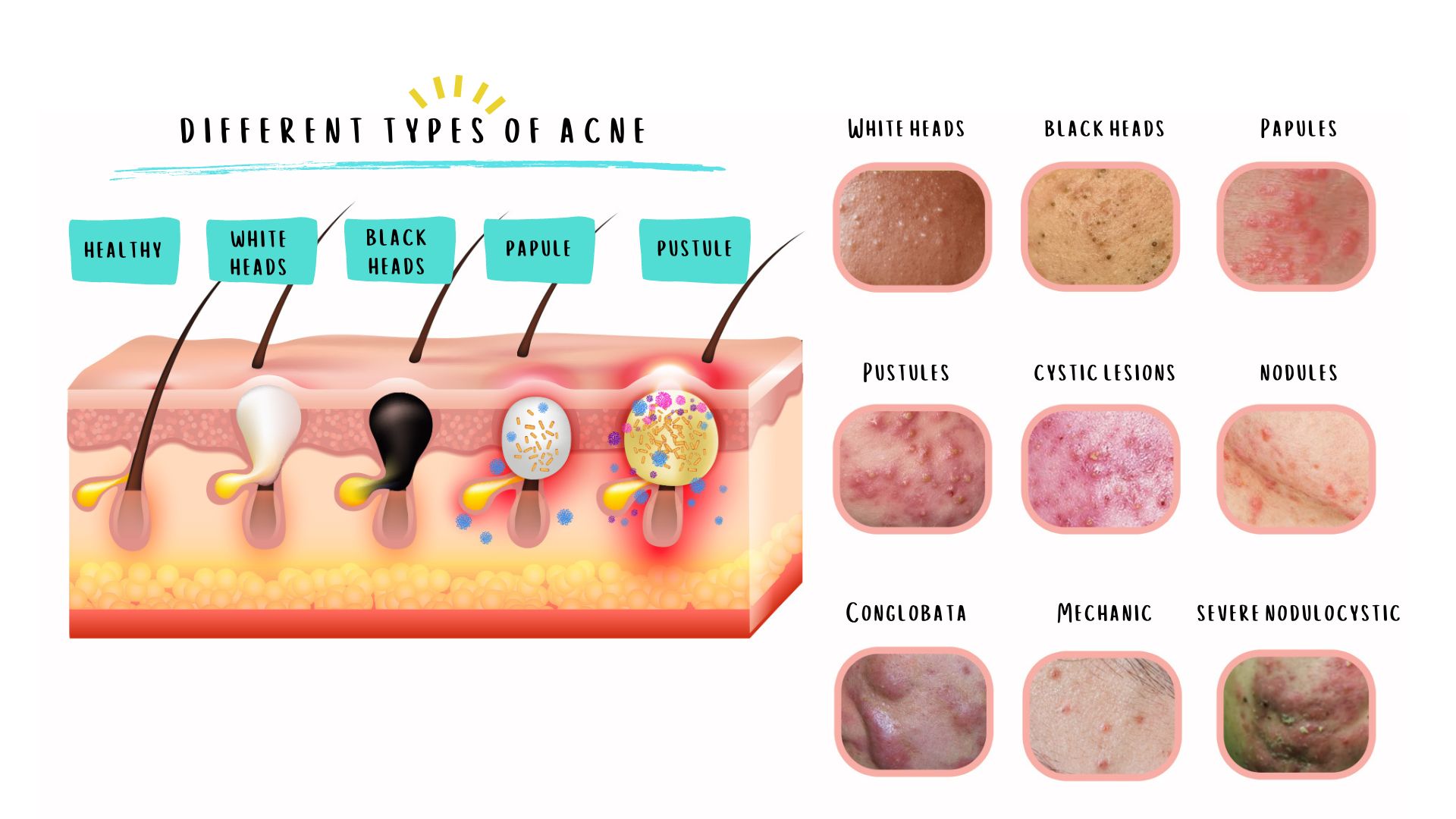
Enlarged Pores
Most pores are so tiny we can hardly see them, sometimes they are more prominent, especially on facial skin. Factors that may cause enlarged pores include:
- Age (As we age, we naturally lose the elasticity in our skin, making pores appear more significant than they are.)
- Genetics
- Oily skin or acne
- Exposure to the sun
- Certain medications
What are the different types of Pores?
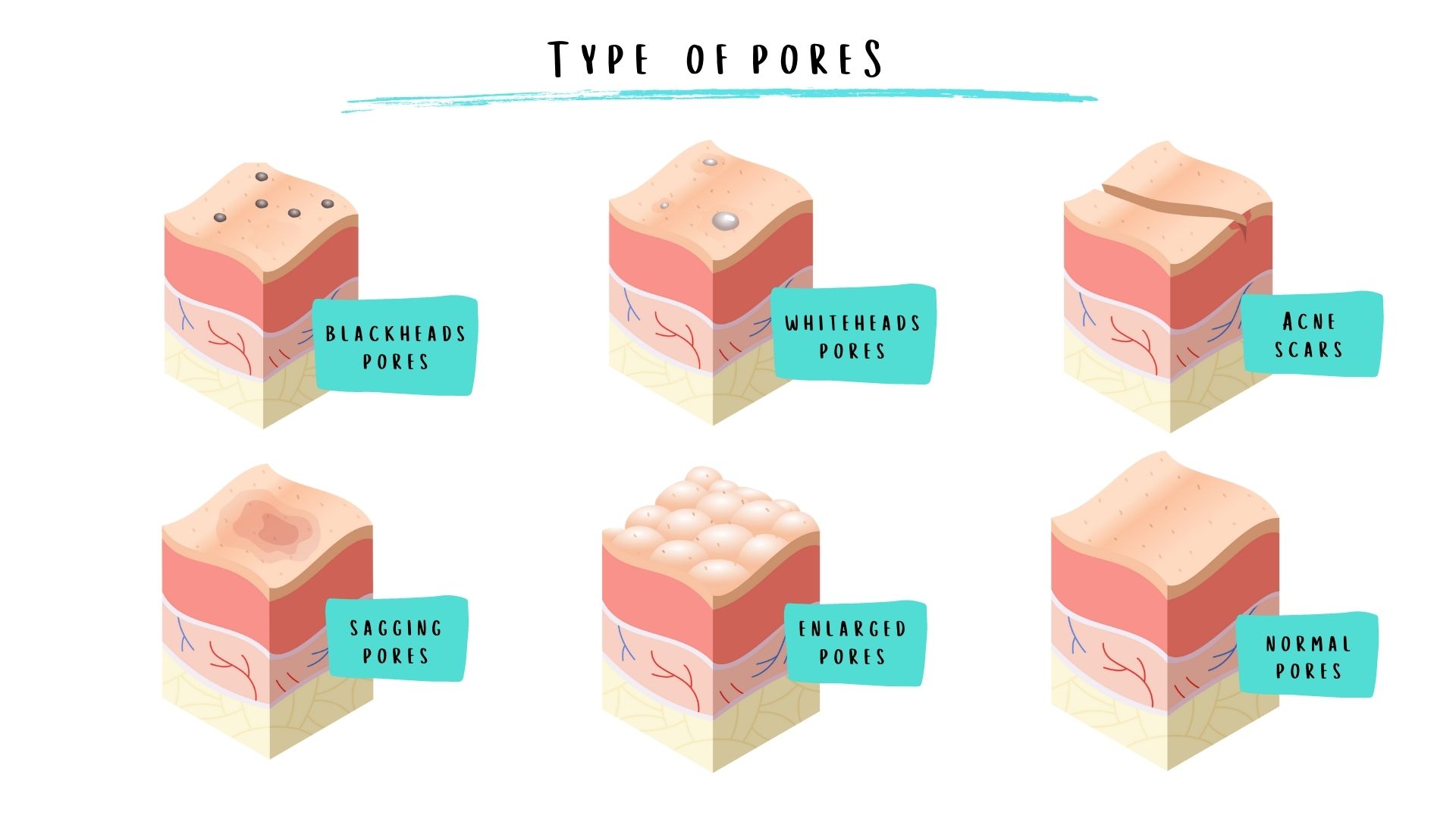
Can I undergo other cosmetic treatments if I am already undergoing this treatment?
Yes! Our clinic recommends Q-Switched (ND-YAG) Laser to go with other treatments such as HIFU, Yellow Laser, LDM and Sharplight IPL.
The Q-Switched (ND-YAG) Laser treatment is also included in the following treatment package:






